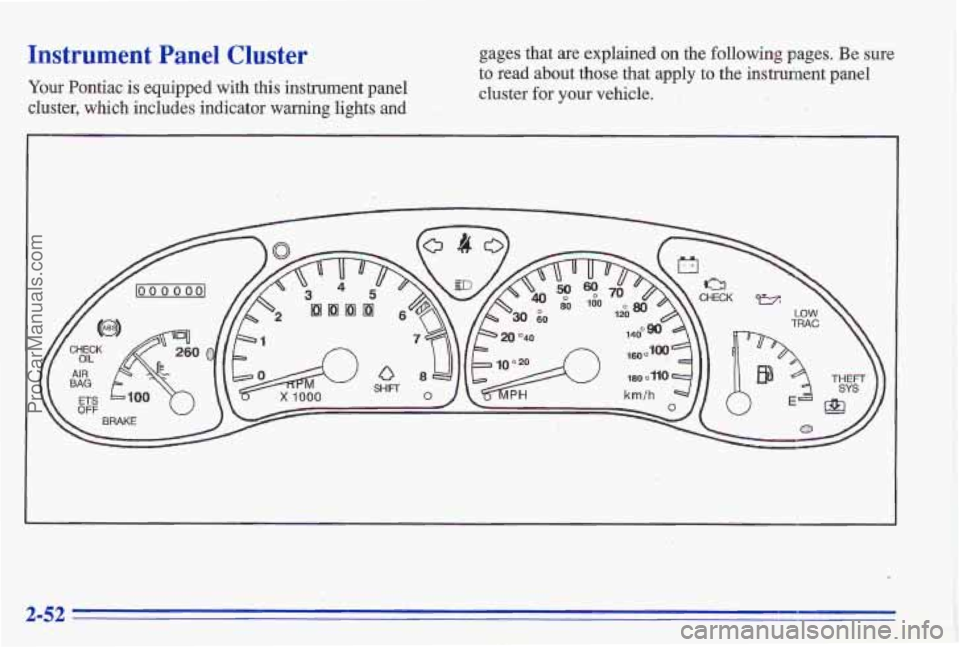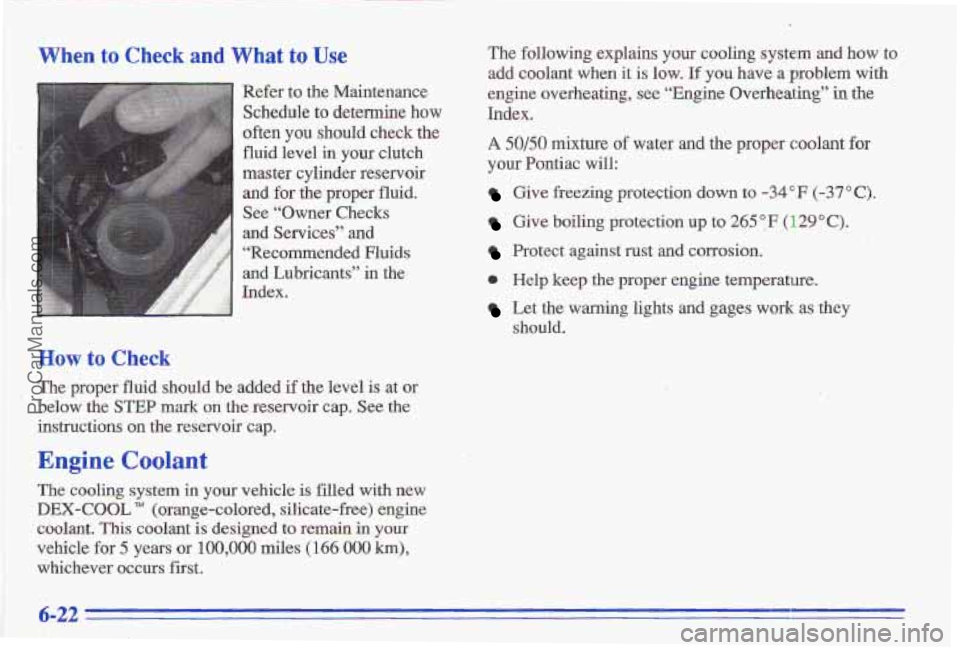1996 PONTIAC GRAND-AM lights
[x] Cancel search: lightsPage 7 of 356

For example,
these symbols
me used on an
original battery:
POSSIBLE A
CAUTION
INJURY
PROTECT EYES BY
SHIELDING
CAUSTIC
ACID COULD BAllERY
CAUSE
BURNS
AVOID
SPARKS OR FLAMES
FLAME
EXPLODE BAllERY
These symbols
are important
for you and
yorr passengers
whenever your
vehicle is
driven:
DOOR LOCK
UNLOCK
FASTEN SEAT
BELTS
Vehicle Symbols
These are some of the symbols you may find on your vehicle.
Op
AIR BAG p
These symbols
have
to do with
your lights:
SIGNALS e
TURN
PARKING
pf
LAMPS
RUNNING
' ' 0
DAYTIME *
LAMPS *
FOG LAMPS $0
These symbols
are
on some of
your controls:
WINDSHIELD
DEFROSTER
WINDOW
DEFOGGER
VENTILATING FAN
These symbols are used on
warning and
indicator lights:
ENGINE k
COOLANT - rd
TEMP -
BRAKE (0)
ENGINE OIL
PRESSURE
ANTI-LOCK
(e)
BRAKES
Here are some
other symbols
you may
see:
FUSE
LIGHTER
m
HORN )tr
SPEAKER
b
il'
FUEL
V
ProCarManuals.com
Page 68 of 356

LOCK (B): Before you pur: the key into the ignition
switch, the switch is
in LOCK. It’s also the only position
in which you can remove the key. This locks your
steering wheel, ignition and transaxle
(on automatic
models).
OFF (C): This position unlocks the steering wheel,
ignition,
and transaxle (on automatic models), but does
not send electrical power to any accessories. Use this
position
if your vehicle must be pushed or towed, but
never
try to push-start your vehicle. A warning chime
will sound if you open the driver’s
door when the
ignition
is off and the key is in the ignition. 1
RUN (D): This position is where the key returns after
you
start your engine and release the switch. The switch
stays
in the RUN position when the engine is running.
But even when the engine
is not running, you can use
RUN to operate your electrical power accessories, and
to display
some instrument panel warning lights.
START (E): This position starts your engine. When the
engine
starts, release the key. The ignition switch will
return
to RUN for normal driving.
Note that even if the engine is not running, the positions
ACCESSORY and RUN are on positions that allow you
to operate your electrical accessories, such as the radio. On manual transaxle
vehicles, turning the key to
LOCK will lock the steering column and result in
a loss of ability to steer the vehicle. This could
cause
a collision. If you need to turn the engine
off while the vehicle is moving, turn the key only
to
OFF. Don’t press the key release button while
the vehicle is moving.
NOTICE:
If your key seems stuck in LOCK and you can’t
turn it,
be sure it is all the way in. If it is, then
turn the steering wheel
left and right while you
turn the key hard. But turn the key only with
your hand. Using a tool to force it could break
the key or the ignition switch. If none of this
works, then your vehicle needs service.
2-12
ProCarManuals.com
Page 88 of 356

Turn and Lane Change Signals
The turn signal has two upward (for right) and two
downward (for left) positions. These positions allow you
to signal a turn or a lane change.
To signal a %urn, move the lever all the way up or down.
When the
turn is finished, the lever will return
automatically.
Q
A green arrow on the
instrument panel
will flash
in the direction of the turn
or lane change.
To signal a lane change; just raise or lower the lever
until the mow starts to flash. Hold it there until you
complete your lane change. The lever will return by
itself when
you release it.
As you signal a turn or a lane change, if the arrows flash
at twice the normal rate, a signal bulb may be burned
out.
If a bulb is burned,out, replace it to help avoid an
accident. If the arrows don't go on at all when you
signal
a turn, check for burned-out bulbs and then check
the fuse (see
"Fuses and Circuit Breakers" in the Index).
Headlamp High/Low Beam
To change the headlamps
from low
bearn to high or
high to
low, pull the turn
signal lever all
the way
toward you. Then release it.
When the high beams are
on, this blue light on the
instrument panel also will
be on.
The headlamp highfiow beam indicator light may flash
if the Daytime Running Lights (Dm) system is
experiencing a problem or if a headlamp is
malfunctioning. ~
2-32
ProCarManuals.com
Page 95 of 356

Lamps
I
Headlamps
Rotate the band counterclockwise to the second position
to turn on:
Headlamps
0 Parking Lamps
Sidemarker Lamps
0 Taillamps
0 Instrument Panel Lights
Rotate the
band clockwise to OFF to turn all the lamps
The
band on the turn signal/multifunction lever controls
your vehicle’s lamps. to turn on:
0 Parking Lamps
0 Sidemarker Lamps
0 Taillamps
Instrument Panel
Lights
2-39
ProCarManuals.com
Page 108 of 356

Instrument Panel Cluster gages that are explained on the following pages. Be sure
cluster, which includes indicator
warning lights and ..
to read about those that apply to the instrument panel
Your Pontiac is equipped with this instrument panel cluster for your vehicle. I.
,' .
ProCarManuals.com
Page 110 of 356

Tachometer
The tachometer shows your
engine speed
in revolutions
per minute (rpm).
I NOTICE:
Do not run your engine at speeds in the red area,
or engine damage may occur.
Warning ,Lights, Gages and
Indicators
This part describes the warning lights and gages that
may be on your vehicle. The pictures will help you
locate them. Warning
lights and gages can signal that something is
wrong before
it becomes serious enough to cause an
expensive repair
or replacement. Paying attention to
your warning lights and gages could also save you or
others from injury.
Warning lights come on when there may be or
is a
problem with one of your vehicle’s functions. As you
will see
in the details on the next few pages, some
warning lights come on briefly when you start the
engine just to let
you know they’re working. If you are
familiar with this section, you should not be alarmed
when this happens.
Gages can indicate when there may be or
is a problem
with one of your vehicle’s functions. Often gages and
warning lights
work together to let you know when
there’s a problem with your vehicle.
When one of the warning lights comes on and stays on
when you are driving, or when one of the gages shows
there may be a problem, check the section that tells
you
what to do about it. Please follow this manual’s advice.
Waiting
to do repairs can be costly -- and even
dangerous.
So please get to know your warning lights
and gages. They’re a
big help.
ProCarManuals.com
Page 164 of 356

Here are some tips on night driving.
Drive defensively.
Don't drink and drive.
Adjust yous inside rearview mirror to reduce the
. ,.* . - !:?<: -. ' ' ,- 1. /. . I .%d. .:,fi$;
,.
..
glare from headlamps behind you.
Since
you can't see as well, you may need to slow
down
and keep more space between you and other
vehicles.
Slow down, especially on higher speed roads. Your
headlamps can light up only
so much ro8ad ahead.
In remote areas, watch for animals.
If you're tired, pull off the road in a safe place and
Night Vision
No one can see as well at night as in the daytime. But as
we get older these differences increase. A 50-year-old
driver may require at least twice as much light to see the
same
thing at night as a 21)-year-old.
What you do in the daytime can also affect your night
vision.
For example, if you spend the day in bright,
sunshine
you are wise to wear sunglasses. YQU~ eyes will
rest, have less trouble adjusting
to night. But if
you're
driving, don't wear sunglasses at night. They may cat
down ol-i glare from headlamps, but they also make a lot
of things invisible.'
You can be temporarily blinded by approaching
headlamps.
It CZUI take a sec'ond or two, or even several
seconds,
for your eyes to readjust to the dark When you
are faced with severe glare (as
horn a driver who
doesn't lower the.high
beams, or a vehicle with
misaimed headlamps), slow down a little. Avoid staring
directly into the approaching headlamps.
Keep your windshield and all the glass on your vehicle ". ' ' ''
clean -- inside and out. Glare at night is'made much
worse by
dirt on the glass, Even the inside of the glass
can
build up a film caused by dust, Dirty glass makes
lights dazzle and flash more
than clean glass would,
making the pupils of your eyqs contract repeatedly.
Remember that your headlamps light up far less
of a
roadway
when you are in a turn or cur&. Keep your
eyes moving; that way, it's easier to pick out dimly
lighted objects. Just
as your headlamps- should be
checked regularly for proper aim, so should your eyes
be exmined regularly. Some drivers suffer from night
blindness
-- the inability to see in dim light -- and
aren't even aware of it.
. I 1, . ..
..
4-16
ProCarManuals.com
Page 244 of 356

When to Check and What to Use
Refer to the Maintenance
Schedule
to determine how
often you should check the
fluid level
in your clutch
master cylinder reservoir and for
the proper fluid.
See “Owner Checks
and Services” and
“Recommended Fluids
and Lubricants” in the
How tu Check
The proper fluid should be added if the level is at or
below the
STEP mark on the reservoir cap. See the
instructions
on the reservoir cap.
Engine Coolant
The cooling system in your vehicle is filled with new
DEX-COOL TM (orange-colored, silicate-free) engine
coolant.
This coolant is designed to remain in your
vehicle
for 5 years or 100,000 miles (166 000 h),
whichever occurs first. The
following explains
your cooling system and how to
add coolant when it is low. If you have a problem with
engine overheating, see “Engine Overheating”
in the
Index.
A Sol50 mixture of water and the proper coolant for
your Pontiac will:
Give freezing protection down to -34°F (-37°C).
Give boiling protection up to 265 9 F ( 129 O C).
Protect against rust and corrosion.
0 Help keep the proper engine temperature.
Let the warning lights and gages work as they
should.
6-22
ProCarManuals.com